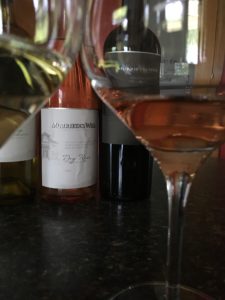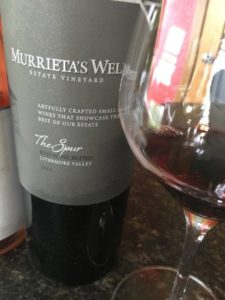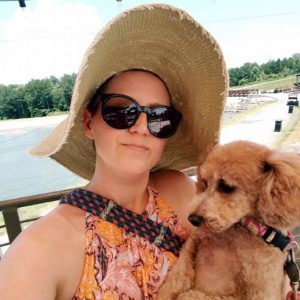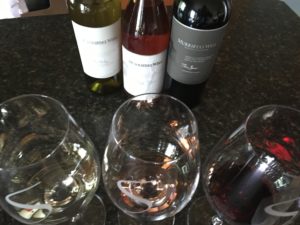Episode 126: The Wines of Murrieta’s Well
Live from Livermore Valley (although pre-recorded with Steph, Val, & three wines), Director of Winemaking Robbie Meyer brings a generous pour of winemaking knowledge – & charm – to the show this week. This is our first episode about the Livermore Valley, and we learned a lot. The history of the region is fascinating, and we were absolutely blown away by the wines of Murrieta’s Well! We hope you enjoy this chat with Robbie as much as we did! Cheers ~ [ad]
Main Discussion: Murrieta’s Well Wines
This week we are “blending” it up a bit and tasting some Livermore Valley wines with winemaker Robbie Meyer. All the usual bits – drinking on the show, WinoRadar, and a Factoid – are thoughtfully integrated into this interview and taste-along.
Heads up: we did geek out a little during our interview because that’s how we roll. But Robbie rolled with us and politely entertained our questions about everything from harvest dates to alcohol levels and everything along the way, including grapes, production, blending, and terroir. It goes without saying, we loved us some Robbie and hope you enjoy this episode as much as we did while recording it.
Robbie Meyer, Director of Winemaking
Robbie Meyer joined the Murrieta’s Well winemaking team as Director of Winemaking in 2015. In this role he focuses on small lot harvesting and blending, working to ensure that the vineyards are performing well and the wine quality and style showcase the very best of this historic estate. Robbie’s love of food and wine began at an early age in his native city of Marietta, Georgia and led him to serve as a restaurant wine steward when he was 18. It was his love of food and wine that brought him to study winemaking in California. His studies in plant sciences and chemistry at the University of Georgia were a great match for his graduate work at the University of California, Davis where he received his Master’s Degree in Enology.
Prior to joining Murrieta’s Well, Robbie spent several vintages working with vineyards and wineries in Napa Valley, Sonoma County and Santa Barbara. He has worked at Peter Michael Winery, Lewis Cellars and Jericho Canyon Vineyards to name a few. In addition, he is consulting for several winemaking projects in Napa Valley and Santa Barbara as well as making wine for his own label, Peirson Meyer (which some of you may remember as L’Angevin).
Robbie lives in northern Napa Valley with his wife and two sons.
Murrietta’s Well – Deep History
Murrieta’s Well, a Wente-owned winery, can trace its beginnings back to the 1800s. Louis Mel brought cuttings from France, including Châteaux such as d’Yquem & Margaux, and began developing agriculture and the vineyards in California. It should be noted that he established one of the first gravity flow winery facilities in the US, and that building is still there today. Robbie also tells us that everything on the current property was built from materials, like the rocks and gravel material, from the Arroyo canyon. Talk about terroir!
Wente acquired the property in 1930s as Louis Mel was leaving the wine business. While the winery bldg itself was unused for many years, Eric, Phil and Carolyn, the fourth generation, brought the now 120+ year old building and property back to life. This was the genesis of Murrietta’s Well in the 1980’s.
Murrietta’s well is also based on a prominent – and sometimes controversial – figure in California’s history, a bandito named Joaquin Murireta. Legend has it the Joaquin would bring his horses to the artesian well on the property for the best water around. This was Phil Wente’s inspiration for the winery’s name. While varietally labeled wines are created at the winery, the blends were given proprietary names that hearken to bandito life as in The Whip and The Spur, which we tasted along with Robbie.
The Vines
So what about the old vines? We often hear stories of vines that exist from the 1800s. Yet it’s natural for vines to decline in terms of production as they age or succumb to diseases. Robbie explains to us how the original genetic material from Louis Mel’s cuttings live on today. The new, younger materials are vital to a productive vineyard.
Wente and Murrieta’s Well are really part of CA history, with over 130 years of farming and vineyards and the early introduction of some of these classic varieties to the states. Some of the first cuttings ever brought over, included Chardonnay from Montpelier, and, as we mentioned, the Bordeaux cuttings. However, while the original plantings brought over by Louis Mel are not literally present in the form of ancient, gnarly vines, the direct-descendants are. That original plant material has been maintained on site at Wente through the clones. Bud wood is introduced to the property and propagated into new plants. Cuttings from these plants are then taken to start new vines; the cycle continues.
What’s Special About the Livermore Valley
After a little gab about the grape grandparents, we pressed on with terroir talk and what makes Livermore Valley a great grape place. It’s funny that the American wine heritage and history is so prominent here, but it’s a wine region that is rarely mentioned in mainstream wine chatter.
Livermore is a uniquely situated valley that runs east to west. Most regions have a north-south orientation. This allows the breezes from the San Francisco Bay to directly inject a marine influence, providing cool mornings and evenings to balance out the warm days. Grapes can not only ripen fully, but the diurnal swings allow for the preservation of acidity.
For more information about the Livermore Valley, check out the Livermore Valley Winegrower’s Association website .
Farming by the Acre
Robbie shared with us a little more about how the vineyards are managed acre-by-acre. Each individual site has different exposures, soils, water tables, etc. Then each variety is cared for relative to what happens on that single acre, taking into account the root stock, irrigation blocks, pruning, canopy management, and other factors. This is unique to a standard approach of having an assigned protocol to each grape variety.
As an example, the Sauvignon Blanc in one area of the vineyard may be treated quite differently in another area or block of vineyard. This philosophy is seemingly opposite what many of us study with respect to old world wine regions where vineyard management is often regulated. We believe this brings home the point that nothing in wine is definitive.
But what is definitive is that we love wine, and we couldn’t wait to get into the tasting.
In Our Glasses – a Sip-along With Robbie Meyer (Wines Provided by Murrieta’s Well)
Wine Number 1: The Whip, 2015 – 30% SB, 30% Semillon, 30% Chardonnay, 7% Viognier, 3% Muscat Canelli
We started with The Whip. Like the inspiration behind the name, this is a white wine that is created to round up a variety of cuisine in terms of pairings. It’s a true food wine with a “whip” of fresh acidity to the palate.
Each variety is brought in and made into the best possible version of resulting wine. In other words, each grape is made into its respective varietal wine from estate fruit. Then Robbie sits down at the blending table to assemble the final wine.
He wants a consistent style that delivers striking aromatics of floral (Viognier, Muscat Canelli or Orange Muscat) and fruit with the weight, density, substance, texture and fullness (Semillon, Chardonnay, Viognier) on the palate. Yet, the wine can still deliver fresh acidity (Sauvignon Blanc).
While the varieties and blends differ from vintage to vintage, the style is going to fall in line with a desired profile considered consistently reliable to the winery’s fans. Blends are intended to be fun and delicious. They can also rock a greater variety of foods as a lot more organoleptic characteristic ground can be covered when it comes to components, textures and flavors.
Robbie also addresses packaging updates and the screwcap on The Whip. It was a preference input from consumers. While Robbie prefers a cork finish and the sensory experience associated with it, he appreciates the simplicity and convenience of the screwcap. Also, it communicates the fun and “drink young” intention of the wine.
Wine Number 2: Dry Rosé , 2016 – 55% Grenache, 45% Counoise
Fresh, floral, fruit is the main objective of the rosé wine. Can this wine mature with bottle time? Absolutely. The blends are not only unique, but so is the intention of the winemaker.
Counoise brings structure and natural acidity; Grenache brings spice, according to Robbie. While the alcohol is over 14%, it is so well integrated. The flavors and aromatics are what Robbie focuses on during production, and he finds (generally) rosé wines are enjoyable in their youth for the fruit, floral, and freshness qualities.
The grapes are farmed, harvested and fermented with the intention of making rosé wine, and not a bi-product of red wine production as in some wineries and regions. Whole cluster pressing is happening instead of bleeding off the juice from red wine tanks. Some barrel fermentation and yeast experimentation will vary from year-to-year, but the goal is immediately enjoyable wines that can be drunk alone or enjoyed with a variety of foods.
Wine Number 3: The Spur, 2014 – 45% Cabernet Sauvignon, 22% Petite Sirah, 14% Petit Verdot, 10% Merlot, 9% Cabernet Franc
This is Steph’s favorite, gets two thumbs up from Val, and an enthusiastic “yum” from Robbie during our conversation. The Spur is a red blend that is made to meet the “delicious” objective. It is a bottled representation of a survey of the property by bringing in grapes from different vineyards. For example, the Cabernet Sauvignon comes from three different vineyards.
Robbie is looking for not only structure and body, but red fruits, approach-ability and, again, this is where the blending brings the magic. The mid palate is fleshed out by bringing Petite Sirah into a classic Bordeaux blend. Remember, each variety brings something unique to the blending party, right?
This wine was all at once described as joyful, comforting and “outdoor dining and indoor lounging” by Steph. It was a “liquid cashmere throw on a cool fall day” to Val. While this is a $30 bottle we thought it drank like more expensive wines of this type.
Robbie has emotion at the forefront of his winemaking intention, and sees it as more of a craft than art. Where art conveys emotion, the craft allows those emotions to evoke themselves and what it brings to the consumers. And we were so happy to tap into it with The Spur!
Robbie’s Romanée
Finally, about 45 minutes into the recording, Robbie shares with us his very unique embarrassing wine story. We’d also like to mention this is the second week in a row a guest has shared an embarrassing wine story that happened during those impressionable teenage years. You won’t want to miss this adorable share!
Connect With Robbie
Visit Murrieta’s Well in the Livermore Valley. You can also find them on MurrietasWell.com.
Also, be sure check out his own wines at PeirsonMeyer.com. These are his Napa and Sonoma County wines.
A Little Extra
There will be some bonus content for patrons at https://www.patreon.com/winetwofivepodcast from pre-interview chatter and some prohibition era history. There’s also a little post-interview gush about how much fun we had with Robbie.
Shoutouts
- Robbie Meyer for being our guest today!
- Emma Thomas from Balzac Communications and Marketing for making this interview happen
- Heather Everett, Wente Brand Manager, for sending us the beautifully presented wines
- Andrea Rogers from Colorado Creative Beverage Marketing for connection us all
Patreon Love
Thank you to our Patrons who support us on the crowdfunding platform called Patreon!
“TENacious Tasters”
- Jeff E from the We Like Drinking podcast
- Lynn from Savor the Harvest blog
- Sebastian of Sassi Italy Tours
- Jen in Maryland (and the world, according to her Instagram feed)
- David and Lisa in Illinois
“It’s not five o’clock and we don’t care” Listeners
- Meg in South Dakota
- Clay in Arizona
- Jon in California
- Andrew in California
- Aswani in California
- Chantel in Ontario, Canada
- Mary Lou in Pennsylvania
- Cathie in Georgia
- Chris and Janet in Colorado
- Steve in Illinois
- Cathey in Tennessee
- Renee in Illinois
- Diane in Colorado
- Our newest supporter in North Carolina is Ashley! Here’s a little more about her.
“I Wanted to let y’all know, I just signed up as a “It’s Not 5 O’Clock & We Don’t Care” Patreon, because I love your show SO. MUCH.
I work at (the Huntersville, NC) Whole Foods as a Demo Chef. Part of my job means sampling out lots of wine, including creating food pairings, selecting cheeses & charcuterie, etc. Listening to your show the last month or so has upped my demo game SO. MUCH. I’ve started going through the W25 archive on Stitcher & listening to every episode in order. (I’m currently on #27.)
One especially cool thing on my “Wino Radar”: thanks to your mention of “Cork Dork” in one of the episodes, I bought & read it. I ended up loving it so much, I chose it for the October book-of-the-month for the store’s Culinary Book Club, of which I am the founder/leader. We will be discussing it on October 1st, & conducting a blind tasting of our own: all of my regular customers are so excited about it too now!
Thanks again for everything you do!”
Ashley
“Tastemaker Listeners”
- David in Scotland
- Carole in Kentucky
“Winetastic Listeners”
- Laura
Go to our Patreon page for details www.patreon.com/winetwofivepodcast on how to be entered into our monthly drawing, exclusive content, and swag.
Connect
We are here for you every week… and in between episodes, you can find us on the social spaces @WineTwoFive and we encourage you to join our private FaceBook group called Wine Two Five Community!
Connect with Val on Twitter @WineGalUnboxed and as Vino With Val on Facebook, Instagram & Pinterest.
Connect with Steph on Twitter, Pinterest and Instagram as TheWineHeroine.

